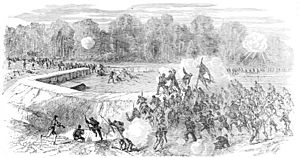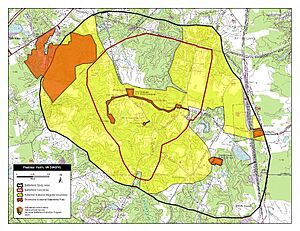Battle of Peebles's Farm facts for kids
Quick facts for kids Battle of Peebles's Farm |
|||||||
|---|---|---|---|---|---|---|---|
| Part of the American Civil War | |||||||
 5th Corps attacking a Confederate fort, September 30th |
|||||||
|
|||||||
| Belligerents | |||||||
| Commanders and leaders | |||||||
| Gouverneur K. Warren | A. P. Hill | ||||||
| Units involved | |||||||
| V Corps | Third Corps | ||||||
| Strength | |||||||
| 29,800 | 10,000 | ||||||
| Casualties and losses | |||||||
| 2,889 | ~900 | ||||||
The Battle of Peebles's Farm was an important fight during the American Civil War. It was also known as the Battle of Poplar Springs Church. This battle was part of a larger plan by the Union Army to attack the Confederate States Army around Petersburg and Richmond, Virginia. These cities were very important to the Confederacy. The battle happened during the long Siege of Petersburg.
Contents
Why the Battle Happened
In September 1864, Union General Ulysses S. Grant had a big plan. He wanted to attack both sides of General Robert E. Lee's Confederate army at the same time.
One attack was in the east. It was led by Major General Benjamin Butler and his Army of the James. They aimed for Confederate defenses at Chaffin's Farm.
The other attack was in the west. This was the Battle of Peebles's Farm. It was led by Major General Gouverneur K. Warren and his V Corps. Brigadier General David McMurtrie Gregg's cavalry also joined. Other Union troops from the IX Corps and II Corps were ready to help.
Grant had two main goals for Warren's attack. First, he wanted to draw Confederate soldiers away from Fort Harrison. Union forces had captured this fort, and the Confederates were trying to get it back. Second, Grant wanted to use the chance that Lee's lines might be weaker. Lee had moved some troops to retake Fort Harrison.
Warren's attack aimed for the Boydton Plank Road. This road was a key supply route for Petersburg. It brought supplies from a Confederate rail station to the south. The Confederates were building new defenses along this road. They also had a temporary defense line along Squirrel Level Road.
How the Battle Unfolded
On September 30, 1864, General Warren and General Gregg began their march. They moved along Poplar Springs Road toward the Squirrel Level line. This was near Peebles's Farm and Poplar Springs Church. This was the same day Lee was trying to get Fort Harrison back.
Lee had indeed moved many soldiers from this area. So, Warren's attack was against a smaller Confederate force. This force was led by Lieutenant General A. P. Hill.
Around 1:00 PM, Union Brigadier General Charles Griffin led the attack. They charged the Confederates near Poplar Springs Church. Griffin's troops quickly captured Fort Archer. This was on the far end of the Confederate line. The Confederate soldiers on the Squirrel Level line ran away so fast that few were captured.
General Warren stopped the attack to make the new position stronger. He did not want to advance too far ahead of the IX Corps. The Union attack forced Lee to call back some of his troops. These troops were on their way to Fort Harrison.
The Union IX Corps, led by Major General John Parke, moved up on Warren's left. But they did not connect well with Warren's V Corps. Meanwhile, Confederate Major General Henry Heth was getting ready to counterattack.
Around 4:30 PM, Heth's counterattack began. It pushed back the IX Corps and forced one of its brigades to surrender. Warren, who had worried about a counterattack, helped rally the scattered Union troops. They stopped Heth's attack, and the fighting calmed down.
Heth tried another attack the next day, October 1. This attack was stopped at the Battle of Vaughan Road. A cavalry attack by Major General Wade Hampton III was also pushed back.
On October 2, the Union position got stronger. Brigadier General Gershom Mott's division from the II Corps arrived. Mott led a Union attack that day. Their goal was the Boydton Plank Road. The attack easily took Fort McRae. But they were stopped before reaching the Boydton Plank Road itself.
What Happened Next
After the battle, the Confederates lost parts of their defenses on both sides of their lines. The Union army pushed their siege lines further. They were now even closer to their main goal, the Boydton Plank Road. The Union army was now strongly dug in around Peebles's Farm. Later that month, the II Corps would try again to cut the Boydton Plank Road.
Protecting the Battlefield
Today, groups like the American Battlefield Trust work to save these historic places. They and their partners have protected about 90 acres of the Peebles's Farm battlefield. This land is now part of Pamplin Historical Park in Petersburg, Virginia.


